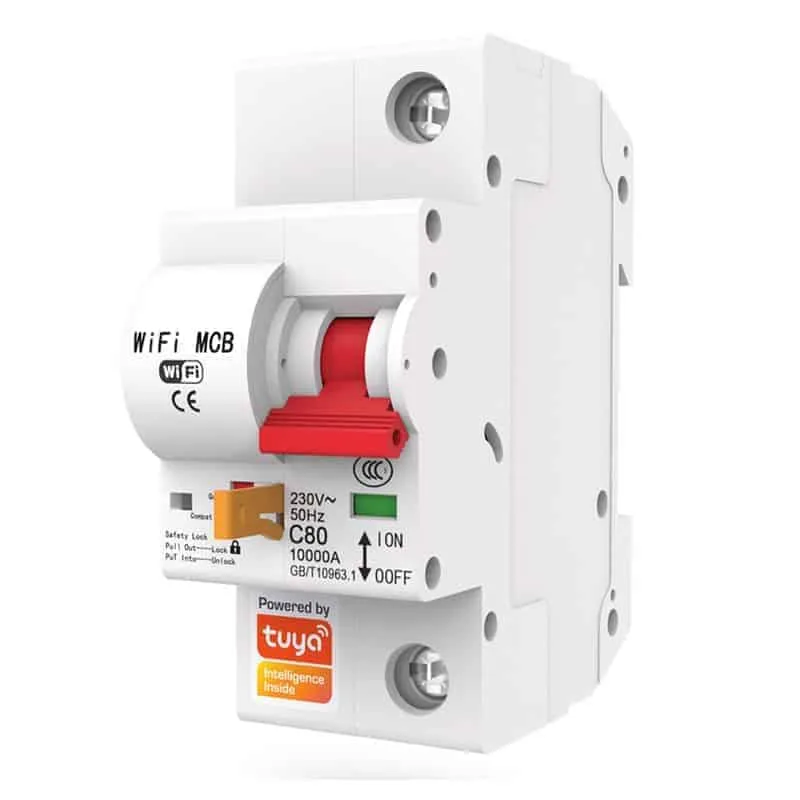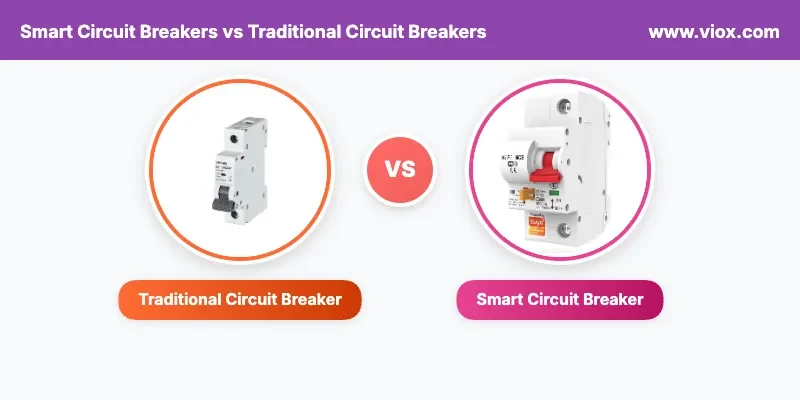Smart circuit breakers offer more than just protection—they deliver real-time data, remote control, and energy optimization, unlike traditional breakers that simply serve as safeguards against electrical overloads. If you’re deciding between smart and traditional circuit breakers, this comprehensive guide will help you make the right choice for your home’s electrical safety, energy efficiency, and future-proofing needs.
Raskt svar: Smart circuit breakers provide all the protection of traditional breakers plus Wi-Fi connectivity, remote monitoring, energy management, and smartphone control. Traditional breakers cost $5-250 per unit while smart breakers range from $120-500+ but offer long-term energy savings and enhanced safety features.
What Are Smart Circuit Breakers vs Traditional Circuit Breakers?
Traditional Circuit Breakers: The Reliable Foundation

Traditional or regular circuit breakers are automatic electrical switches designed to shield circuits from potential damage caused by overloads or short circuits. These mechanical devices have protected homes for decades by automatically cutting power when electrical faults are detected.
Viktige egenskaper:
- Purely mechanical operation
- Manual reset required after tripping
- Basic overcurrent protection
- No connectivity features
- Cost range: $5-250 per breaker
Smart Circuit Breakers: The Digital Evolution

Smart circuit breakers offer all the functionality of a regular breaker and more, with capabilities for remote monitoring and control, collecting real-time usage data, and offering users unprecedented control over their electrical systems.
Avanserte funksjoner:
- Wi-Fi, Bluetooth, or Zigbee connectivity
- Smartphone app control
- Real-time energy monitoring
- Remote on/off capability
- Price premium of at least $1,000 over traditional systems
Smart vs Traditional Circuit Breakers: Complete Comparison Table
| Funksjon | Traditional Circuit Breakers | Smarte sikringsbrytere |
|---|---|---|
| Grunnleggende beskyttelse | ✅ Overload & short circuit | ✅ Overload & short circuit |
| Kostnad per enhet | $5-250 | $120-500+ |
| Installasjonskostnad | $313-375 per breaker | $400-800 per breaker |
| Fjernkontroll | ❌ Manual only | ✅ Smartphone app |
| Energiovervåking | ❌ No data | ✅ Real-time usage |
| Connectivity | ❌ None | ✅ Wi-Fi/Bluetooth |
| Notifications | ❌ None | ✅ Instant alerts |
| Load Management | ❌ Static | ✅ Dynamic optimization |
| Vedlikehold | Manual inspection | Predictive alerts |
| Levetid | 25–40 år | 15-25 years (estimated) |
| NEC-samsvar | ✅ Fully compliant | ✅ UL certified |
Key Differences Between Smart and Traditional Circuit Breakers
1. Connectivity and Control
- Require physical access to reset
- No remote monitoring capabilities
- Manual operation only
Smart Breakers:
- Can connect to the internet and be controlled remotely, either through a smartphone or a computer
- Voice control integration with smart home systems
- Automated scheduling and load management
2. Monitoring and Data Collection
Traditional Breakers:
- No energy usage data
- Basic trip indication only
- Manual fault detection
Smart Breakers:
- Monitor and report on vital details such as energy consumption, load on each circuit, and instances of circuit trips in real-time
- Historical usage patterns
- Forutseende vedlikeholdsvarsler
3. Safety and Protection Features
Both types meet essential safety standards, but smart breakers offer enhanced protection:
Safety Standards Compliance:
- AFCIs are evaluated to UL 1699, the Standard for Arc-Fault Circuit-Interrupters
- GFCIs meet UL 943, the Standard for Ground-Fault Circuit-Interrupters
- Both comply with NEC 2023 requirements
Applications and Use Cases: When to Choose Each Type
Choose Traditional Circuit Breakers When:
- Budget-Conscious Projects
- New construction with tight budgets
- Simple electrical systems
- No smart home integration plans
- Reliability-First Applications
- Traditional electrical panels and circuit breakers typically last for decades with minimal maintenance
- Industrial applications requiring proven technology
- Areas with unreliable internet connectivity
- Code Compliance Only
- Meeting basic NEC requirements
- Standard residential applications
- Straightforward electrical needs
Choose Smart Circuit Breakers When:
- Smart Home Integration
- Transforms traditional loadcenters into modular smart panels
- Hjemmeautomatiseringssystemer
- IoT device integration
- Energy Management Priorities
- Smart panels can let you keep your existing service—but use it more intelligently
- Solar and battery storage systems
- Peak demand management
- Advanced Safety Requirements
- Real-time notifications regarding potential faults or unusual energy consumption
- Fjernovervåkingsmuligheter
- Predictive maintenance needs
Installation Requirements and Electrical Code Compliance
NEC 2023 Requirements for All Circuit Breakers
The 2023 National Electrical Code includes updates in GFCI protection, AFCI protection, surge protection and other requirements for safe practices:
Mandatory Protection Requirements:
- Residential branch circuits for receptacles and lighting must have AFCI protection
- GFCI protection required for all receptacles rated 60 amp or less within 20 feet of a swimming pool wall
- GFCI protection is required for 125-volt to 250-volt receptacles supplied by single-phase branch circuits rated 150 volts or less to the ground
Installasjonsspesifikasjoner
Panel Requirements:
- Circuit breaker boxes must be installed at a minimum height of 4 feet and a maximum of 6 feet 7 inches
- 3 feet of clearance required, doors must open 90 degrees without obstacles
- Cannot be located in bathrooms
Profesjonell installasjon anbefales:
Both smart and traditional circuit breakers require licensed electrician installation for:
- Electrical permits and inspections
- Verifisering av samsvar med koden
- Safety certification
Cost Analysis and Return on Investment
Sammenligning av innledende investeringer
Traditional Circuit Breaker System:
- Equipment: $5-250 per breaker
- Installation: $313-375 per breaker
- Total: $318-625 per circuit
Smart Circuit Breaker System:
- Equipment: $120-500+ per breaker
- Installation: $400-800 per breaker
- Price premium of at least $1,000 over traditional systems
- Total: $520-1,300+ per circuit
Long-term ROI Considerations
Smart Breaker Benefits:
- Energy consumption optimization (5-15% savings)
- Reduced maintenance costs through predictive alerts
- Enhanced safety reducing insurance claims
- Increased home value for smart home features
Break-even Timeline:
Typically 5-10 years depending on energy usage and utility rates.
Selection Guide: How to Choose the Right Circuit Breaker
Step 1: Assess Your Electrical Needs
Basic Requirements Checklist:
- Current amperage requirements (15A, 20A, 30A, etc.)
- Number of circuits needed
- AFCI/GFCI protection requirements for specific locations
- Future expansion plans
Step 2: Evaluate Smart Features Value
Consider Smart Breakers If You Want:
- Remote monitoring and control
- Energy usage optimization
- Integration with solar/battery systems
- Intelligent load management to avoid main panel upgrades
Step 3: Budget and ROI Analysis
Beregn totale eierkostnader:
- Initial equipment and installation costs
- Potential energy savings over 10-15 years
- Maintenance and replacement considerations
- Smart home integration benefits
Step 4: Future-Proofing Considerations
Technology Trends:
- Smart circuit breakers now offer features like remote monitoring, automatic adjustments, and predictive maintenance
- Increasing integration with renewable energy systems
- Growing smart home adoption rates
Safety Considerations and Expert Tips
⚠️ Safety Warning Box
IMPORTANT: All circuit breaker work must be performed by licensed electricians. Working with electrical panels poses serious injury or death risks from electrocution. Always shut off main power and verify circuits are de-energized before any work.
Ekspertinstallasjonstips
Faglige anbefalinger:
- Size correctly – Match breaker amperage to wire gauge and load requirements
- Follow NEC requirements – Ensure AFCI/GFCI protection where mandated
- Plan for utvidelse – Leave spare slots for future circuit additions
- Quality matters – Choose UL-certified breakers from reputable manufacturers
Common Troubleshooting Issues
Traditional Breaker Problems:
- Frequent tripping (overload or short circuit)
- Won’t reset (mechanical failure)
- Buzzing sounds (loose connections)
Smart Breaker Problems:
- Wi-Fi connectivity issues
- App synchronization problems
- False trip alerts
- Firmware update requirements
Løsninger:
- Regular inspection and maintenance
- Professional electrical assessment
- Manufacturer technical support for smart features
Quick Reference: Circuit Breaker Selection Chart
| Søknad | Recommended Type | Viktige funksjoner | NEC-krav |
|---|---|---|---|
| Basic Residential | Traditional AFCI/GFCI | Overstrømsbeskyttelse | AFCI for bedrooms, living areas |
| Kitchen Circuits | Traditional or Smart GFCI | Jordfeilbeskyttelse | GFCI for all kitchen receptacles |
| Smart Home | Smart Wi-Fi enabled | Remote control, monitoring | Standard safety requirements |
| Solar Integration | Smart load management | Energy optimization | Grid-tie compliance |
| High-usage Areas | Smart with monitoring | Load balancing | Appropriate amperage rating |
Ofte stilte spørsmål
What makes smart circuit breakers different from traditional ones?
Smart breakers offer more than just protection—they deliver real-time data, remote control, and energy optimization, while traditional breakers only provide basic overcurrent protection and require manual operation.
Are smart circuit breakers worth the extra cost?
The value depends on your needs. Smart breakers cost at least $1,000 more than traditional systems but can provide 5-15% energy savings, enhanced safety monitoring, and smart home integration benefits that may justify the investment over time.
Do smart circuit breakers meet electrical code requirements?
Yes, smart circuit breakers must meet the same UL safety standards as traditional breakers. AFCIs are evaluated to UL 1699, the Standard for Arc-Fault Circuit-Interrupters and all installations must comply with NEC 2023 requirements.
Can I install smart circuit breakers myself?
No, circuit breaker installation requires a licensed electrician. Most areas require a permit for electrical installations and professional installation ensures code compliance and safety.
How long do smart circuit breakers last compared to traditional ones?
Traditional electrical panels and circuit breakers typically last for decades with minimal maintenance, while smart breakers have an estimated 15-25 year lifespan due to their electronic components.
What happens if my Wi-Fi goes down with smart circuit breakers?
Smart circuit breakers continue to provide basic protection functions even without internet connectivity. The safety features operate independently, but remote monitoring and control features require network connection.
Can smart circuit breakers help reduce my electricity bill?
Yes, through intelligent load management and energy monitoring. Smart breakers can significantly reduce electricity bills by controlling energy-hungry devices with precision and providing usage insights for optimization.
Are there security concerns with smart circuit breakers?
Reputable manufacturers prioritize data security and user privacy through robust encryption protocols, regular software updates, and stringent security measures to protect against potential threats.
Faglige anbefalinger og neste steg
Når bør du kontakte en elektriker?
Obligatorisk profesjonell konsultasjon:
- Any circuit breaker installation or replacement
- Oppgraderinger av elektriske paneler
- Verifisering av samsvar med koden
- Safety inspections
Choosing the Right Professional
Electrician Selection Criteria:
- Licensed and insured
- Experience with smart home technology
- Familiarity with local electrical codes
- Manufacturer certification for specific smart breaker brands
Planning Your Electrical Upgrade
Step-by-Step Process:
- Assessment – Professional electrical system evaluation
- Planning – Circuit requirements and smart feature needs
- Permitting – Innhente nødvendige elektriske tillatelser
- Installasjon – Professional breaker installation and testing
- Commissioning – System setup and smart feature configuration
Conclusion: Making the Smart Choice for Your Home
The choice between smart and traditional circuit breakers depends on your specific needs, budget, and future plans. Traditional breakers remain an excellent choice for basic protection and cost-conscious projects, offering decades of reliable service at $5-250 per unit.
Smart circuit breakers represent the future of electrical safety and energy management, providing real-time data, remote control, and energy optimization capabilities that justify their higher initial cost for many homeowners. With manufacturers continuously innovating to keep up with the growing demands of modern electrical systems, smart breakers are becoming increasingly valuable for energy efficiency and home automation.
Relatert
Hva er den vanligste bryterstørrelsen i et boligelt elektrisk panel
IEC 60898-1 vs IEC 60947-2: Komplett veiledning til standarder for elektriske sikringsbrytere
Kortslutning vs. jordfeil vs. overbelastning: Hvilken elektrisk feil er farligst?
Hva er en miniatyrsikringsbryter (MCB): Komplett veiledning for sikkerhet og valg


